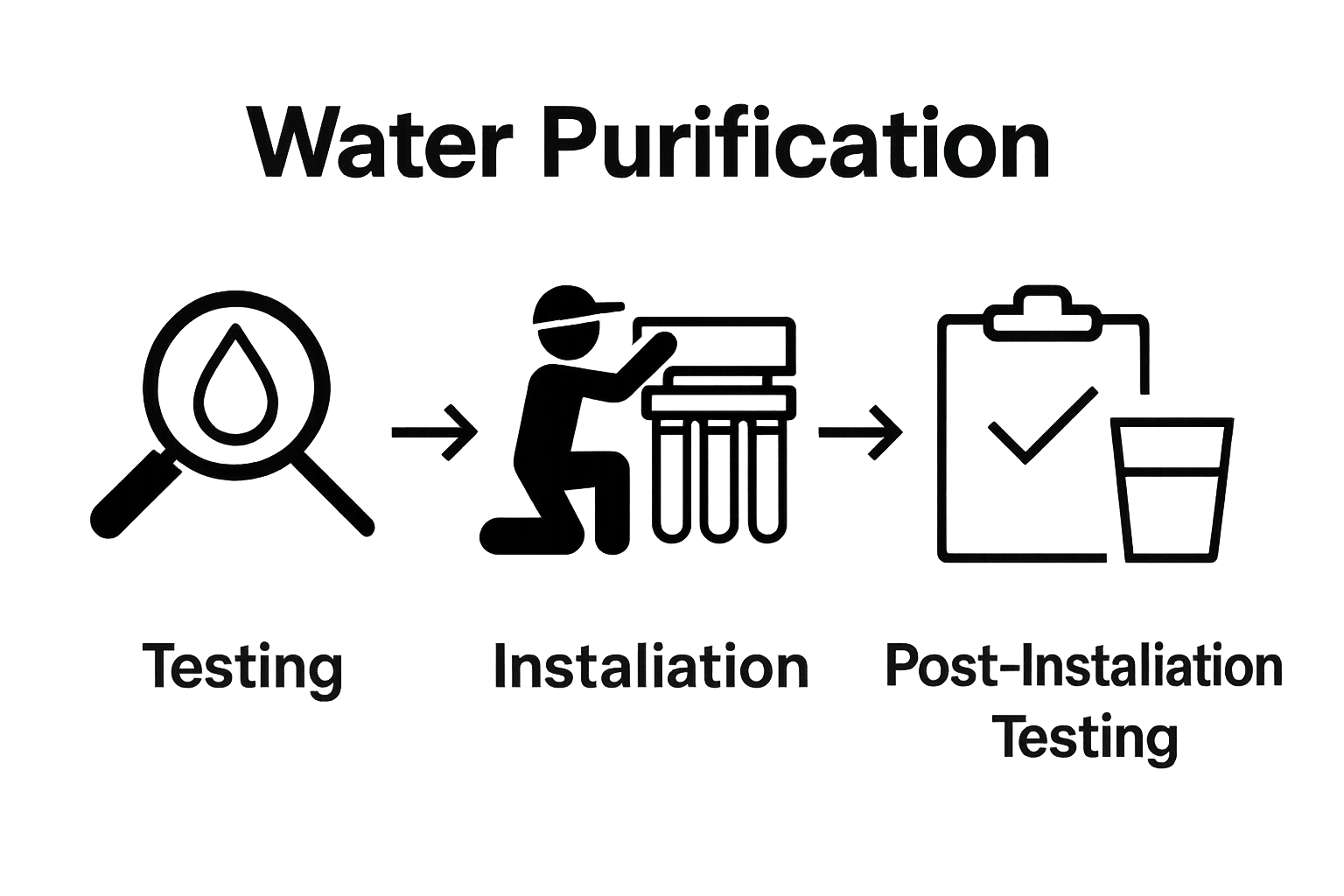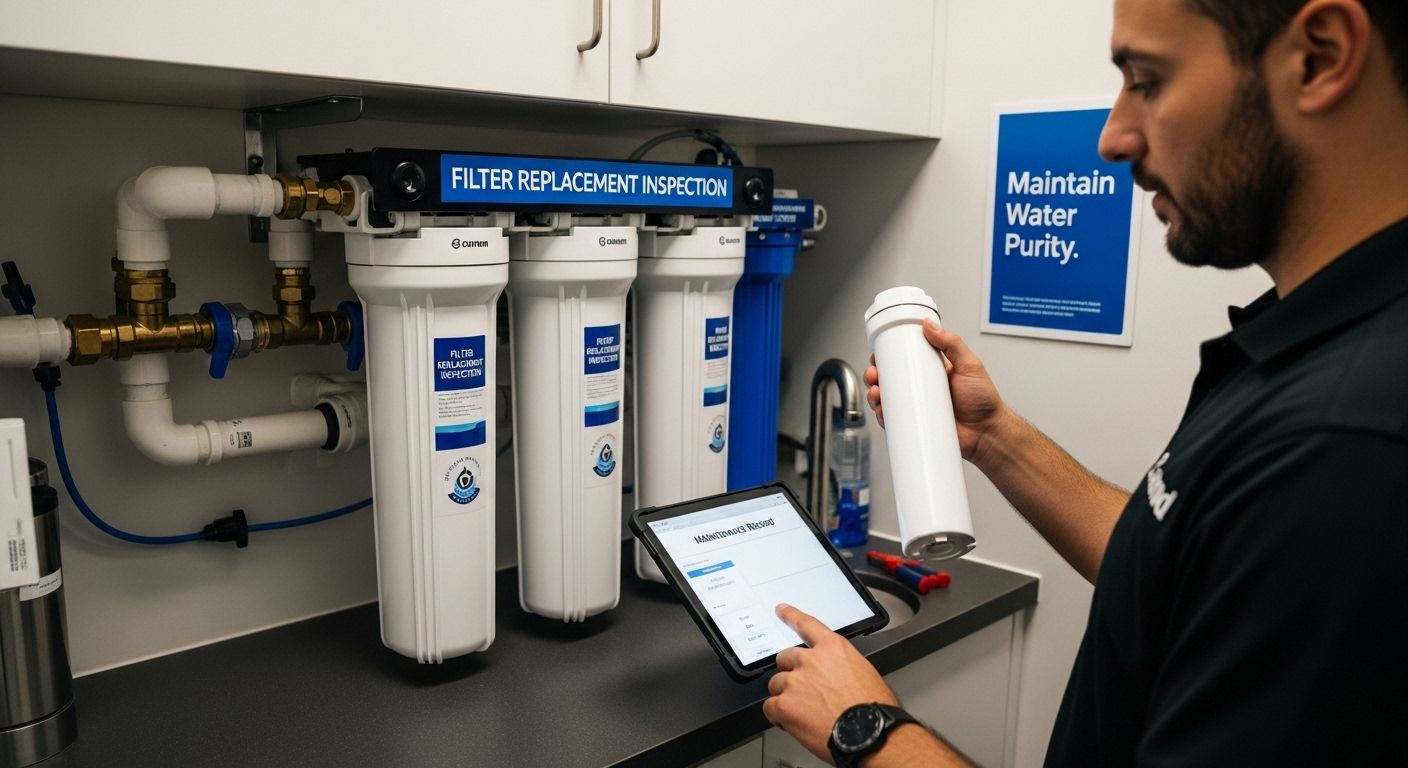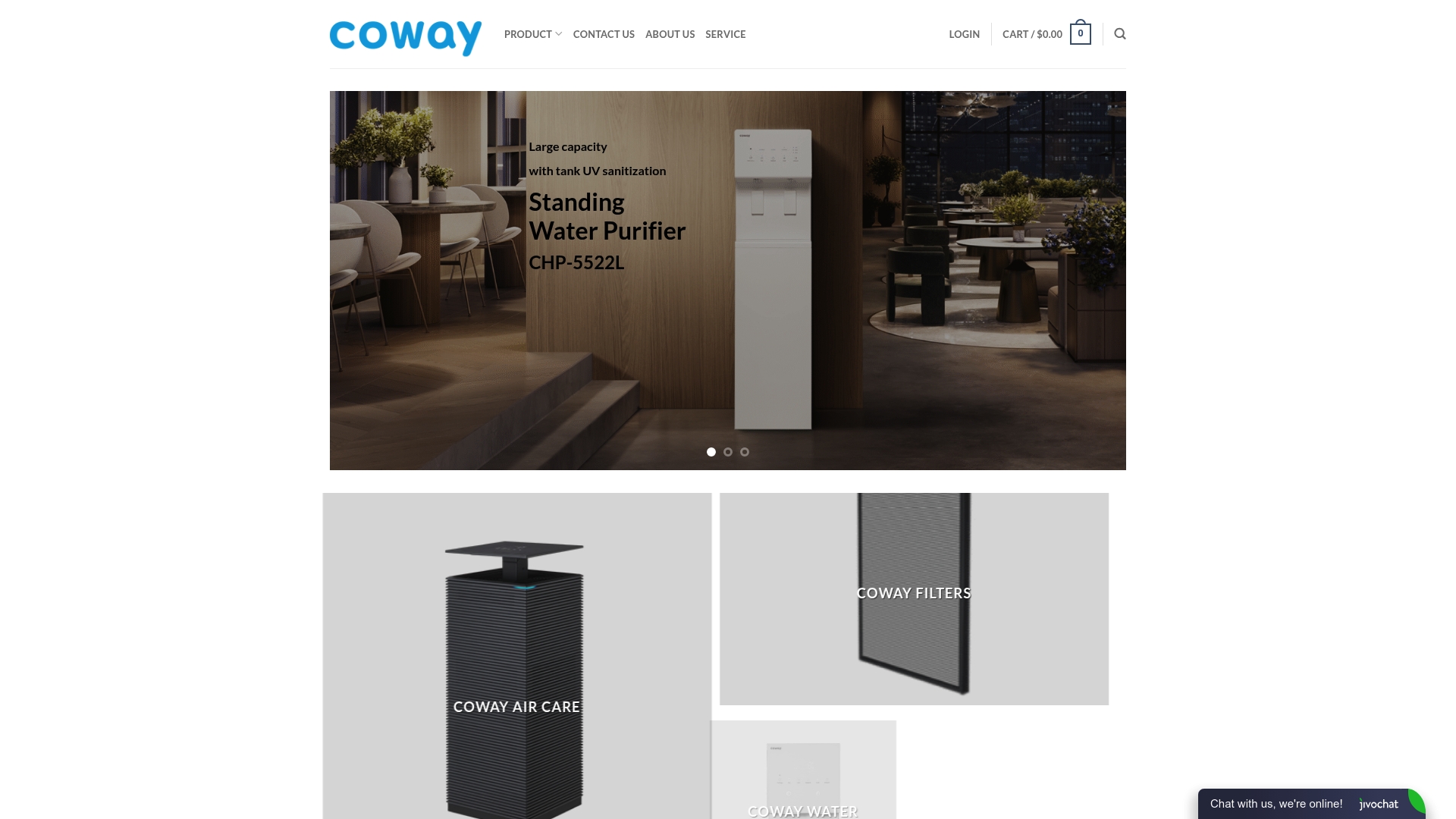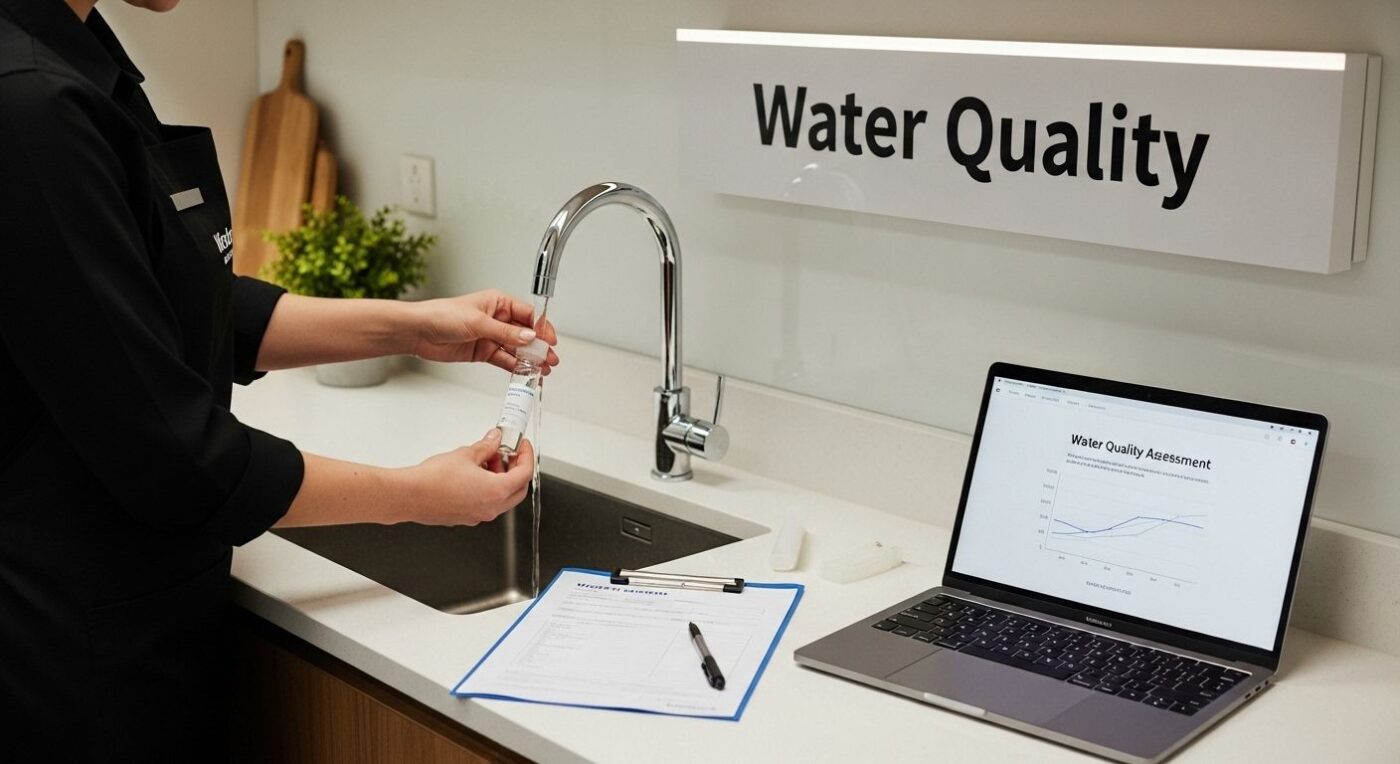Uncategorized
Complete Office Water Purification Guide for Healthier Spaces
Clean water at the office seems like a given, but what flows from your tap might not be as pure as you think. Water quality can vary dramatically even from one office to the next, raising unexpected concerns about health and safety. Most people focus only on taste or appearance, yet the real risks often hide where you least expect them—inside pipes, coolers, and that shiny new dispenser.
Table of Contents
- Step 1: Assess Your Current Water Quality
- Step 2: Research Available Water Purification Systems
- Step 3: Select The Right Purification Method
- Step 4: Install The Chosen Water Purification System
- Step 5: Test Water Purity Post-Installation
- Step 6: Maintain And Monitor Water Quality Regularly
Quick Summary
| Key Point | Explanation |
|---|---|
| 1. Assess office water quality first | Testing determines contaminants and health risks, guiding purification needs accurately. |
| 2. Research suitable purification systems | Match technologies like reverse osmosis to specific contaminants identified in testing. |
| 3. Choose a tailored purification method | Select systems based on effectiveness and alignment with detected contaminants. |
| 4. Ensure professional installation | Expert setup guarantees optimal system performance and compliance with specifications. |
| 5. Conduct regular maintenance and monitoring | Ongoing checks and documentation ensure system reliability and continued water quality safety. |
Step 1: Assess Your Current Water Quality
Understanding your office’s water quality is the critical first step in developing an effective water purification strategy. This foundational assessment helps you identify potential contaminants, understand potential health risks, and select the most appropriate purification solutions for your workspace. Water quality can vary dramatically, even within the same city or building complex, making a comprehensive evaluation essential.
To begin your water quality assessment, you’ll need to gather water samples and conduct thorough testing. Professional water testing provides the most accurate results. Contact a certified water testing laboratory that specializes in commercial and office water analysis. These experts can comprehensively examine your water for a wide range of potential contaminants including heavy metals, microorganisms, chemical pollutants, and mineral content.
The testing process typically involves collecting water samples from multiple sources within your office environment – kitchen sinks, water coolers, and drinking fountains. Each sample will be analyzed for various parameters such as pH levels, total dissolved solids, bacterial presence, and specific chemical compounds. Learn more about advanced water testing techniques that can help you understand your water’s comprehensive profile.
Key verification indicators that your water quality assessment is complete include:
- Comprehensive lab report detailing all detected contaminants
- Comparison of test results against EPA drinking water standards
- Identification of specific water treatment needs for your office
After receiving your test results, you’ll be equipped to make informed decisions about the most suitable water purification systems. The data will reveal whether you need advanced filtration for heavy metals, UV sanitization for microbial control, or specialized treatment for specific regional water challenges. This methodical approach ensures that your subsequent water purification efforts are precisely targeted and scientifically grounded.
Step 2: Research Available Water Purification Systems
After completing your water quality assessment, the next critical phase involves researching water purification systems tailored to your office’s specific needs. Water purification technologies have evolved dramatically, offering sophisticated solutions that go far beyond traditional filtration methods. Your goal is to match your water quality challenges with the most effective and efficient purification approach.
Begin by exploring different purification technologies such as reverse osmosis, activated carbon filtration, ultraviolet sanitization, and ion exchange systems. Each technology addresses specific water contaminants uniquely. Reverse osmosis, for instance, excels at removing dissolved solids and heavy metals, while activated carbon filters are exceptional at eliminating chlorine, sediment, and organic compounds. Explore our comprehensive guide to water purification methods to understand the nuanced differences between these technologies.
Commercial water purification systems require careful evaluation based on several critical factors. Consider your office’s water consumption volume, available installation space, maintenance requirements, and long term operational costs. Consulting with water treatment professionals can provide detailed insights into system performance, filtration rates, and compatibility with your specific water quality profile.
Here is a comparison of common office water purification technologies to help you match solutions to your specific contaminants.
| Purification Method | Main Contaminants Removed | Key Benefits | Limitations |
|---|---|---|---|
| Reverse Osmosis | Heavy metals, dissolved solids, salts, fluoride | High effectiveness for many contaminants | Can be slow, wastes some water |
| Activated Carbon Filter | Chlorine, sediment, organic compounds | Improves taste and odor, easy maintenance | Less effective for dissolved minerals |
| Ultraviolet Sanitization | Bacteria, viruses, microorganisms | Chemical-free microbial control | Does not remove chemical contaminants |
| Ion Exchange | Hardness minerals (calcium, magnesium) | Softens water, reduces scaling | Does not target bacteria or organics |
| Multi-Stage Filtration | Multiple (depends on stages) | Comprehensive protection, versatile | May have higher upfront cost/maintenance |
Key verification indicators that your research is comprehensive include:
- Detailed comparison matrix of potential water purification systems
- Cost benefit analysis for each technology
- Compatibility assessment with your office’s water quality test results
Remember that selecting the right water purification system is an investment in your workplace’s health and productivity. The most advanced system is not always the best system – the optimal choice is one that precisely matches your specific water quality challenges while remaining cost effective and operationally efficient.
Step 3: Select the Right Purification Method
Selecting the right water purification method transforms your office’s water quality from uncertain to exceptional. The perfect purification system is not a one size fits all solution, but a carefully tailored approach that addresses your specific water quality challenges identified in previous testing.
Transition from research to selection by creating a comprehensive evaluation matrix that compares potential purification technologies against your office’s unique requirements. Prioritize systems that demonstrate proven effectiveness for the specific contaminants detected in your water quality assessment. Some purification technologies excel at removing heavy metals, while others specialize in eliminating microbiological threats or reducing chemical pollutants. Discover advanced water purification strategies that can help refine your selection process.
Consider practical implementation factors beyond filtration performance. Installation requirements, maintenance complexity, replacement filter costs, and energy consumption are critical considerations that impact long term operational efficiency. Multi stage filtration systems often provide the most comprehensive protection, combining technologies like activated carbon, reverse osmosis, and ultraviolet sanitization to create a robust water treatment solution. Professional water treatment consultants can provide invaluable guidance in navigating these complex technical considerations.
Key verification indicators that you have selected the right purification method include:
- Alignment between purification technology and specific water contaminants
- Comprehensive cost analysis including initial investment and ongoing maintenance
- Verification of system certification from recognized water quality standards organizations
Your goal is not just removing contaminants but creating a sustainable, efficient water purification solution that supports your office’s health, productivity, and operational excellence. The right system acts as a silent guardian, ensuring every drop of water meets the highest quality standards.
Step 4: Install the Chosen Water Purification System
Installing your selected water purification system represents a critical transition from planning to implementation. Professional installation ensures optimal performance and prevents potential operational issues that could compromise your office’s water quality. While some systems might seem straightforward, nuanced technical requirements demand precise execution.
Begin by preparing the installation space meticulously. Verify electrical connections, water line compatibility, and available mounting areas before initiating the installation process. This preparation minimizes potential disruptions and ensures a smooth setup. Explore expert installation guidelines to understand the intricate details of system implementation. Consider hiring certified technicians who specialize in commercial water treatment systems, as they bring expertise in handling complex installation requirements specific to office environments.
Careful consideration must be given to system placement, drainage requirements, and potential infrastructure modifications. Some advanced purification systems require specialized plumbing connections or electrical configurations that go beyond standard installation procedures. Proper positioning impacts not just performance but also maintenance accessibility. Technicians should conduct thorough system testing immediately after installation, checking water flow rates, filtration efficiency, and confirming that all components function precisely as designed.
Key verification indicators that your water purification system is correctly installed include:
- Comprehensive system performance diagnostic report
- Confirmation of all manufacturer specified installation requirements
- Successful initial water quality test post installation
Remember that installation represents more than just physical setup – it is the foundation of your office’s water quality management strategy. A meticulously installed system sets the stage for consistent, reliable water purification that supports workplace health and productivity.
Use this checklist to confirm critical verification points after installing a water purification system in your office.
| Verification Step | Purpose/Outcome |
|---|---|
| System performance diagnostic report completed | Confirms proper function and output quality |
| All manufacturer installation requirements documented | Ensures setup meets safety and warranty specs |
| Initial water quality test after installation conducted | Validates contaminant removal effectiveness |
| System flow rate and filtration efficiency checked | Detects any immediate operational issues |
| Maintenance access and drainage confirmed | Supports easy upkeep and reliability |
Step 5: Test Water Purity Post-Installation
Testing water purity after installation represents the critical validation phase of your office water purification strategy. Water quality verification is not a one time event, but a systematic process that ensures your newly installed system performs exactly as intended. This step transforms technical installation into a measurable health protection mechanism for your workplace.
Initiate comprehensive water testing through accredited laboratory analysis that examines multiple contaminant parameters. Professional testing goes beyond basic visual or taste assessments, providing scientific documentation of water quality. Explore comprehensive water testing protocols to understand the depth of analysis required. Request a detailed report that not only identifies potential contaminants but also compares results against established EPA drinking water standards. This approach provides a forensic level of insight into your office water system’s performance.
Work closely with certified water quality professionals who can interpret complex testing results and recommend immediate corrective actions if any anomalies are detected. Some purification systems might require minor calibration or filter adjustments based on initial test outcomes. Systematic testing creates a baseline for ongoing water quality management, allowing you to track performance, identify potential degradation, and maintain consistent water purity over time.
Key verification indicators that your water purification system passes post installation testing include:

- Comprehensive laboratory analysis report showing contaminant levels below regulatory thresholds
- Confirmation of system filtration efficiency matching manufacturer specifications
- Successful microbiological screening demonstrating absence of harmful bacteria
Remember that water purity testing is an investment in workplace health, transforming your purification system from a technical installation into a proactive health protection strategy.
Step 6: Maintain and Monitor Water Quality Regularly
Regular maintenance and monitoring transform your water purification system from a one time installation into a continuous health protection strategy. Consistent oversight prevents gradual system degradation and ensures your office maintains the highest water quality standards. Think of this process as routine healthcare for your water infrastructure, where preventative actions stop potential problems before they emerge.
Develop a systematic maintenance schedule that includes routine filter replacements, system inspections, and periodic professional evaluations. Most water purification systems require quarterly or semi annual comprehensive assessments to verify optimal performance. Learn about advanced water maintenance best practices to understand the nuanced requirements of different filtration technologies. Professional technicians can conduct detailed diagnostics, checking components like membrane integrity, filtration efficiency, and potential microbial contamination risks.
Implement a comprehensive tracking system that documents every maintenance activity, test result, and system modification. Digital logging provides transparent accountability and helps identify long term performance trends. This documentation becomes crucial for troubleshooting potential issues, managing warranty requirements, and demonstrating your commitment to workplace health and safety. Regular water quality testing should include comprehensive screenings for microbiological contaminants, chemical compositions, and potential heavy metal presence.
Key verification indicators that your maintenance program is effective include:
- Consistent documentation of all maintenance activities
- Quarterly professional system performance evaluations
- Comprehensive water quality test results showing stable, safe parameters
Remember that water quality maintenance is an ongoing commitment. Your proactive approach protects not just the water purification system, but the health and well being of everyone in your workplace.

Upgrade Your Office Water Quality for a Healthier Workspace
Is your office struggling with inconsistent water quality, uncertain safety standards, or outdated filtration systems? Our Complete Office Water Purification Guide highlights the importance of advanced assessment, precise system selection, and ongoing maintenance. Many offices still face hidden contaminants and lack the right purification solutions, which can impact employee health and productivity. You deserve an environment where the water you drink is as pure as your commitment to a healthy workplace. If you are ready to take action, explore our Uncategorized Archives – Coway Water Purifier for expert insights and proven strategies.

Experience the science-backed protection and convenience our Coway water purifier line provides. From smart countertop models to large-capacity solutions with UV sanitization, we offer choices tailored for the office. Transform uncertainty into confidence by choosing a Coway system that makes routine water testing and maintenance effortless. Visit Coway Water Purifier now and discover our range of innovative purifiers. Take this step to secure your office’s health today before another day of unknown risks passes.
Frequently Asked Questions
What are the steps to assess my office’s water quality?
To assess your office’s water quality, gather water samples from various sources and send them to a certified laboratory for testing. The lab will analyze the samples for contaminants like heavy metals, microorganisms, and chemical pollutants, providing a detailed report for your evaluation.
How do I choose the right water purification system for my office?
Selecting the right water purification system involves researching different technologies, such as reverse osmosis or activated carbon filtration, and matching them to the specific contaminants identified in your water quality assessment. Consider factors like water consumption, maintenance needs, and long-term costs.
What maintenance is required for a water purification system?
Regular maintenance includes scheduled filter replacements, system inspections, and periodic professional evaluations to ensure optimal performance. Keeping a maintenance log helps track activities and document water quality test results.
How often should I test the water after installing a purification system?
It’s recommended to perform comprehensive water testing after installation and to conduct regular tests every few months. This ensures that the purification system is functioning effectively and that water quality remains safe over time.
Recommended
- 7 Effective Water Purification Methods for Your Home
- 8 Essential Water Purification Best Practices for Health
- 8 Indoor Air Quality Tips for a Healthier Home
- Understanding Why Change Purifier Filters Matters for Health
- Office Air Quality Solutions for Properties in 2025
- Why a Water Filtration System is Essential – 8th Bend Plumbing Heating and Cooling

